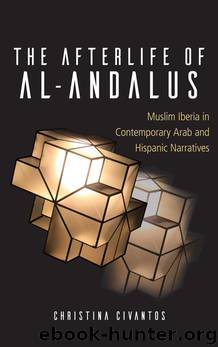The Afterlife of Al-Andalus by Christina Civantos

Author:Christina Civantos
Language: eng
Format: epub
Publisher: State University of New York Press
Published: 2017-03-11T16:00:00+00:00
Boabdil and Migration: Convergence and Divergence of Discourses
In chapter 2’s discussion of Gala’s Averroes and this chapter’s discussion of Gala’s Boabdil and the songs by Carlos Cano and Los Puntos, I examined forms of identification with exiled figures from al-Andalus in relation to the intertwined phenomena of andalucismo and working-class labor migration. Part of what creates the pathos of Boabdil is his position as an exile. For this reason, one branch within the Hispanic archive of representations of Boabdil consists of works that implicitly or explicitly invoke Boabdil to address migration. At the same time, among the few contemporary Arab and North African prose writers who treat Boabdil, all have experienced some form of migration, and all link Boabdil to the figure of the migrant.24 Thus, the intersection of Boabdil and migration is the site of divergences as well as convergences between texts by Hispanic and Arab/North African authors.
First, I would like to examine a node of intersection that is geographically distant from the Strait of Gibraltar, but culturally still quite steeped in questions of Hispanic/Arab identities and specifically the iconic figure of Boabdil. Early twentieth-century Argentina witnessed the consequences of immigration recruitment and industrialization projects that began in the nineteenth century. Argentina’s founding fathers actively recruited European immigrants to boost the labor supply and the “whiteness” of the population, which consisted of criollos (those of Spanish heritage born in Argentina), indigenous peoples, mestizos, and some of mixed African heritage. During the late nineteenth and early twentieth century a deluge of immigrants arrived in Argentina, but they did not fulfill the dreams of progress of the political elite. Most of the immigrants were not the desired Northern Europeans, but instead Southern Europeans, Eastern European Jews, and Levantine Arabs. Rather than arrive to work the land, most joined the process of urbanization that was under way and ended up in cities working in commerce. During the late 1800s, foreign investment interests in Argentina had grown, and criollos regarded this with much distrust. Thus, by the early twentieth century, there was strong xenophobia, much of it directed specifically at Semitic immigrants. The anti-immigrant sentiment grew as part of a broader cultural nationalism. This Argentine criollista movement produced discourses that sought the promotion of rural gaucho customs as the national culture. Intertwined with this, the Hispanism movement promoted cultural ties with Spain and revived interest in Spanish history, including Muslim Iberia and the Reconquista.
Within this context, criollo Argentine writer Enrique Larreta (1875–1961) became famous for his novel, La gloria de don Ramiro (The Glory of Don Ramiro, 1908), about a Spaniard in the post-Reconquista Spain of Felipe II who thinks he has “pure” Christian blood but is actually the son of a Moor.25 Although that novel was considered a paragon of the literary style known as modernismo, Larreta was criticized by criollistas for focusing on a Spanish rather than Argentine context. Years later Larreta published a novel that is set in early twentieth-century rural Argentina, but nonetheless refers repeatedly to Boabdil: Zogoibi (1926).26
Download
This site does not store any files on its server. We only index and link to content provided by other sites. Please contact the content providers to delete copyright contents if any and email us, we'll remove relevant links or contents immediately.
| African | Asian |
| Australian & Oceanian | Canadian |
| Caribbean & Latin American | European |
| Jewish | Middle Eastern |
| Russian | United States |
4 3 2 1: A Novel by Paul Auster(11098)
The handmaid's tale by Margaret Atwood(6893)
Giovanni's Room by James Baldwin(5925)
Big Magic: Creative Living Beyond Fear by Elizabeth Gilbert(4755)
Asking the Right Questions: A Guide to Critical Thinking by M. Neil Browne & Stuart M. Keeley(4620)
On Writing A Memoir of the Craft by Stephen King(4245)
Ego Is the Enemy by Ryan Holiday(4019)
Ken Follett - World without end by Ken Follett(3990)
The Body: A Guide for Occupants by Bill Bryson(3853)
Bluets by Maggie Nelson(3740)
Adulting by Kelly Williams Brown(3701)
Guilty Pleasures by Laurell K Hamilton(3613)
Eat That Frog! by Brian Tracy(3545)
White Noise - A Novel by Don DeLillo(3453)
The Poetry of Pablo Neruda by Pablo Neruda(3386)
Alive: The Story of the Andes Survivors by Piers Paul Read(3332)
The Book of Joy by Dalai Lama(3257)
The Bookshop by Penelope Fitzgerald(3246)
Fingerprints of the Gods by Graham Hancock(3238)
